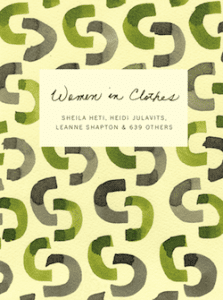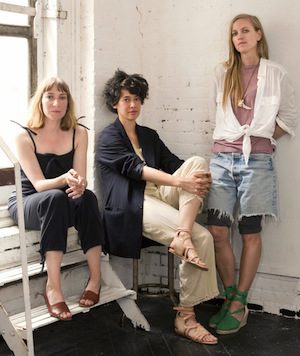
I distinctly remember the first time I understood what it meant to be unfashionable. I was about to enter the 9th grade at a very tony prep school. Growing up I had always worn secondhand clothing; my parents didn’t believe in buying new things.
Faced with the prospect of classrooms packed with fancy stylish rich kids, I begged my mother to take me to the mall. For a new school, I knew I needed new clothes. I knew what kind of girls awaited me in those hallways. I remember the outfit I bought so clearly: at Wet Seal, lavender denim shorts, white v-neck with lavender flower print. I even bought a lavender scrunchie and a pair of white and lavender socks that I wore with lavender Keds. Look at me, I thought, I match. I’ll be one of them.
When I showed up to school the first day, people either didn’t register that I existed or snickered at my outfit, which I learned was not only so last year, it was like so last decade. I was crushed. The girls were wearing clear mascara! I had never even heard of clear mascara. I learned a valuable lesson that day: by trying to dress like what I thought I should dress like, I ruined everything. Had I just worn the bric-a-brac rag style of gender-neutral secondhand clothing I had been embracing for years, I’d have been fine. Instead they knew how desperate I had been to impress them, to conform. By trying to dress as someone I wasn’t, I lost the ability to be who I was.
I wonder, looking back, what my life would have been like at 13, had I read a book like Women in Clothes. A collaged, zine-like anthology, edited by Sheila Heti, Heidi Julavits and Leanne Shapton, Women In Clothes is a welcome life raft in a sea of what can be, for many women, confusion and mixed messages about why to wear what, when and how to wear it—and more importantly, how to intuit and shape your own style.
In Women In Clothes we meet 642 role models; a variety of voices and bodies, all with unique approaches to style. Lengthy surveys were sent to a number of women, whose responses were then gathered and arranged into sections like breasts, shopping, and glamour. Reading about clothing, bodies, and feelings on fashion from this multitude of women left me feeling both inspired and relieved. It reminded me that to some degree, we all experience similar anxieties around how we are seen in the world. As women, everything we say with how we dress is scrutinized. How can we create freedom and fun in the things we choose to wear?
In my case, I slowly formed a style by watching my role models. My mother made pancakes in black silk negligees and high heels. My high school English teacher wore grey linen sacks and red lipstick with a pageboy haircut. My older sister wore cuffed denim shorts and sprayed her bangs. My high school nemeses wore spaghetti-strapped tank tops and short shorts. Bjork and her mini buns. Joni Mitchell and her lengths. I wasn’t any of these women, and yet this was the raw material from which I assembled my own look, either in alliance or defiance. What I ended up doing was wearing 1940s industrial pencil suits and eventually shaving my head. I did what I could with what I had and where I was. But it took a long time to gain the confidence to branch out; my own look was a collage of my surroundings, local thrift stores, and magazines from the library, and a touch of my own strange, innate individual style. It was a statement of what I borrowed as much as what I rejected.
That process—of observing, co-opting and reinterpreting—is what Women in Clothes offers: a sampling of amazing women sharing and presenting their lives and identities and dailyness as intertwined with what they wear, how they wear it, and why. It gives women an opportunity to see themselves through the lives of other women. While certain celebs are given air time (Lena Dunham, Miranda July, Molly Ringwald, Cindy Sherman, Roxane Gay, Tavi Gevinson), it’s the everyday woman who holds down the fort in these pages, and the book’s ultimate strength lies in the diversity of its voices.
The range of stories and voices includes Ly Ky Tran’s personal account of growing up as a Vietnamese immigrant making cummerbunds in the family’s NYC apartment; Juliet Jacques on learning how to dress like a woman; Reba Sikder, a garment worker who survived the deadly collapse of a factory in Bangladesh; Kim Gordon discussing coolness; Ruth Reichel discussing her different disguises. It’s this mix of seriousness and lightness that gives the book its unique and varied pleasures. Vapid consumer desire brushes up against the politics of clothing. Emily Gould’s tale of buying a Marc Jacobs purse sits in the same book that features images of someone’s collection of bobby pins.

The book also features incredibly moving images of mothers submitted by their daughters – images taken before they had children. In fact, much of the book is a tapestry of how mothers influence their daughters both in style of dress and in life choices and attitudes. I knew my mother had filled out a survey for this book, but I hadn’t read her submission; imagine my surprise at finding her words about how her husband didn’t appreciate it when she dressed up sexily in a silk nightgown, or how she now dresses up for her work, even though her patients are at the brink of death.
What makes the book so powerful is that we are given not only a new way of seeing fashion through the lives of women, but also a new way of seeing the lives of women through fashion. We hear from voices not normally featured in the world of fashion writing. We hear tips and tricks, vulnerable admissions, and compliments from women to other women. Several times in the book I thought, Oh yes, I want to try that, or oh right, that’s not me.
Early in the book, Heti writes that her boyfriend talked about his interest in clothes as a hobby and that “the important thing about a hobby is that it allows you to relate to people you wouldn’t normally relate to.” Because we all wear clothes, partly out of law, it’s something that all of us can discuss, even those of us who think we don’t think about clothing, or pay much attention to it. Getting dressed and leaving the house is in fact a “hobby” that binds us together.
The vast categories of “women” and “clothing” make the prospect of creating a book about the two seem unfathomable, yet the patchwork of oral histories presented in this book gives us the world of women in swatches of fabric, lipstick, various rings, and hand-me-downs. It’s a feat of collaboration, a true artistic leap, and an example of crowd-sourced writing. It’s a book that makes the world feel more intimate at once.
And if nothing else, Women in Clothes serves as a kind of adorable “fuck you” to the world of women’s fashion magazines. The majority of writing about fashion, taste, and clothing is clouded by consumerism. Since most of us aren’t buying the entire look or even the accessories featured in fashion magazines, where can we go to learn about the more philosophical, personal, emotional, complicated approaches to style and dress? A section of the book by Leanne Shapton features Zosia Mamet in a black dance outfit, re-enacting poses from fashion media over the years. Her contorted body holding ridiculous poses makes you realize just how absurd the imagery of the fashion world is, and how it contorts our ideas of what we should be looking like.
The book also reveals a truth: No one can be taught how to dress. A similar thing can be said of art. People must be directed towards themselves, their voices, their bodies, and through that revelation the outward expression reveals itself more truthfully.
I have to admit that when I filled out the survey for this book early on (I have one line in the book), I met with the same anxieties that I had when dressing for that first day of high school. I was writing a style questionnaire and it was for a book! I wanted to sound cool! Stylish! Looking back, my questionnaire seems affected and postured at times (I wanted to sound fashionable), and honest and vulnerable at others (I wanted to be real). In a recent interview on Harper’s blog, the editors discuss the book, and Leanne Shapton says, “When pieces came in, we could smell it a mile off if a woman was trying to impress us and trying to seem cool.”
I guess, at 35, I still struggle with how to present myself authentically. As a complicated person, how do I pick the clothes that say “me”? Even on that first day of high school, that lavender outfit wasn’t me, and then again it was. I want to both impress others to some degree and still be myself. The push-pull will always remain. I think this is true for many of us. We have things we want to wear, but we question them, and things we do wear, and we question them, too. How and when do we take risks, both in fashion and in life? How do we define our own style?
Women in Clothes is a godsend for women who don’t feel fashionable by fashion’s standards. It’s a bible of how to dress, specifically because it isn’t. Maybe someone can go back and give it to me on that first day of high school. Then I could take the bus right back home, change into my pastiche of vintage clothing, and show up looking like the kind of girl who pieced herself together from a world of influences. Dressing as I wanted, so I could be the woman in clothes I am today.




